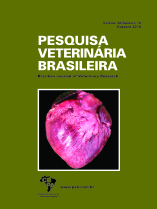 |
|
|
|
Year 2018 - Volume 38, Number 10
|

|
Experimental poisoning by Brachiaria decumbens in rabbits, 38(10):1885-1889
|
ABSTRACT.- Utiumi K.U., Albuquerque A.S., Burque A.S., Souza F.R., Sonne L., Varaschin M.S., Raymundo D.L. & Peconick A.P. 2018. Experimental poisoning by Brachiaria decumbens in rabbits. [Intoxicação experimental por Brachiaria decumbens em coelhos.] Pesquisa Veterinária Brasileira 38(10):1885-1889. Setor de Medicina Veterinária Preventiva, Departamento de Medicina Veterinária, Universidade Federal de Lavras, Cx. Postal 3037, Lavras, MG 37200-000, Brazil. E-mail: ki_uemura@yahoo.com.br
Brachiaria spp. are important sources of forage for ruminants in Brazil, due to the easy cultivation, good resistance to drought, good adaptation to different soils and low maintenance cost. However, the ingestion of this grass has been related to photosensitization outbreaks in cattle and sheep with significant economic losses. The hepatotoxic effects related to the ingestion of grass are the formation of crystals and foamy macrophages due to the accumulation of toxic metabolites. The use of cattle and sheep in experiments involving the plant presents several obstacles in the ethical, economic and animal management. The objective of this study was to evaluate the sensitivity of rabbits as an experimental model for B. decumbens poisoning. Two experiments were carried out. In Experiment 1 four rabbits received the fresh plant in daily doses of 10, 20, 40 and 80g/kg body weight for 120 days. In Experiment 2 three rabbits received the fresh plant in amounts of 500g daily with duration of 210 days. The animals of Experiment 1 showed no clinical signs and no macroscopic and microscopic changes characteristic of B. decumbens poisoning. In Experiment 2 the animals also showed no clinical signs or significant macroscopic alterations. Histological analysis showed isolated foamy macrophages or present in random groups of cells in the liver and mesenteric lymph nodes. Samples of liver and mesenteric lymph nodes of the rabbits of Experiment 2 were submitted to the lectin-histochemistry technique. The WGA, sWGA and RCA lectins showed reactivity in foamy macrophages in both organs. This is the first study of our knowledge that demonstrates histopathological lesions caused expetimentally by Brachiaria spp. in rabbits, demonstrating its potential as an animal model. |
| |
|
|
| |
|
 |